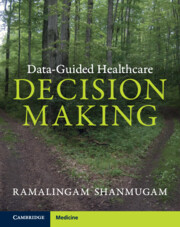Book contents
- Data-Guided Healthcare Decision-Making
- Data-Guided Healthcare Decision-Making
- Copyright page
- Dedication
- Contents
- Figures
- Tables
- About the Author
- Preface
- Glossary
- Notations and Symbols
- Prologue
- Introduction
- Chapter 1 Why and How Healthcare Decisions Are Made
- Chapter 2 Are Data-Guided Healthcare Decisions Superior?
- Chapter 3 Software
- Chapter 4 How to Collect Authentic Data
- Chapter 5 Uncertainties and Their Impact on Healthcare Decisions
- Chapter 6 Why Models Are Important in Healthcare
- Chapter 7 How Healthcare Decision Trees Emerge and Function
- Chapter 8 How Are Group Decisions Practiced in Healthcare?
- Chapter 9 Tracing and Remedying Root Causes of Adversities
- Chapter 10 Healthcare Decision-Making for Cost-Effectiveness
- Chapter 11 Risk Analysis in Healthcare Decision-Making
- Chapter 12 Evaluation of Healthcare Programs
- Chapter 13 Six Sigma and Lean Management in Healthcare Sectors
- Chapter 14 Forecasting in Healthcare Sectors
- Epilogue
- Appendix Statistical Tables
- Index
- References
Chapter 13 - Six Sigma and Lean Management in Healthcare Sectors
Published online by Cambridge University Press: 13 July 2023
- Data-Guided Healthcare Decision-Making
- Data-Guided Healthcare Decision-Making
- Copyright page
- Dedication
- Contents
- Figures
- Tables
- About the Author
- Preface
- Glossary
- Notations and Symbols
- Prologue
- Introduction
- Chapter 1 Why and How Healthcare Decisions Are Made
- Chapter 2 Are Data-Guided Healthcare Decisions Superior?
- Chapter 3 Software
- Chapter 4 How to Collect Authentic Data
- Chapter 5 Uncertainties and Their Impact on Healthcare Decisions
- Chapter 6 Why Models Are Important in Healthcare
- Chapter 7 How Healthcare Decision Trees Emerge and Function
- Chapter 8 How Are Group Decisions Practiced in Healthcare?
- Chapter 9 Tracing and Remedying Root Causes of Adversities
- Chapter 10 Healthcare Decision-Making for Cost-Effectiveness
- Chapter 11 Risk Analysis in Healthcare Decision-Making
- Chapter 12 Evaluation of Healthcare Programs
- Chapter 13 Six Sigma and Lean Management in Healthcare Sectors
- Chapter 14 Forecasting in Healthcare Sectors
- Epilogue
- Appendix Statistical Tables
- Index
- References
Summary
Six Sigma methods and lean management principles yield high-quality healthcare services to patients in hospitals, clinical, and health agencies. Hence, it is worthwhile to learn, apply, and appreciate them. Six Sigma comprises a rigorous, well-focused, and scientific approach to improve the quality of healthcare operations. Healthcare professionals and patients are equally fond of the Six Sigma methods and lean management principles. The basic Six Sigma concept provides effective incorporation of statistical properties. The approach originated from the so-called Gaussian (normal) frequency pattern. Analysts who desire to apply the Six Sigma methods or lean management principles ought to confirm whether the collected data have Gaussian frequency patterns under their original scale or in a transformed scale.
The variables emerge from a quantitatively measurable attribute of the quality of the sample units. The sample units in this context are patients who receive treatment for an illness or medical professionals who deliver healthcare services to patients. The Six Sigma methods are based on the statistical properties of Gaussian data. Recall from your statistics courses that 99.974% of the standardized Z-values of a measurable attribute/variable fall between −3.0 and 3.0 in their frequency pattern.
- Type
- Chapter
- Information
- Data-Guided Healthcare Decision Making , pp. 349 - 425Publisher: Cambridge University PressPrint publication year: 2023



